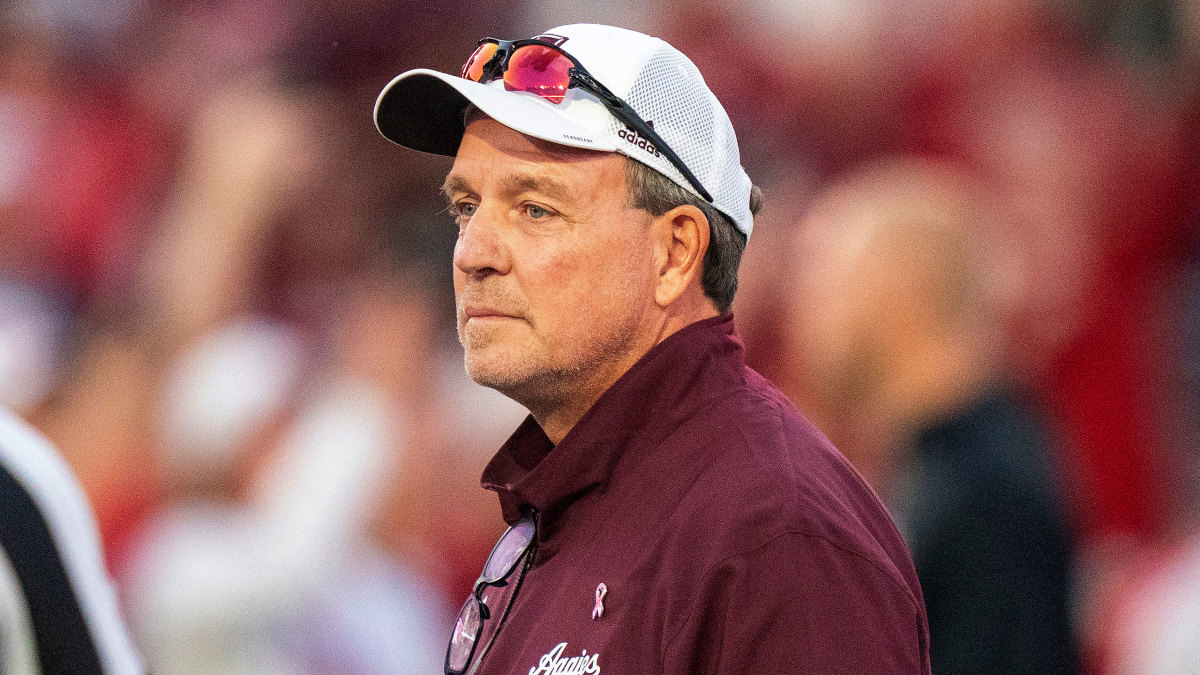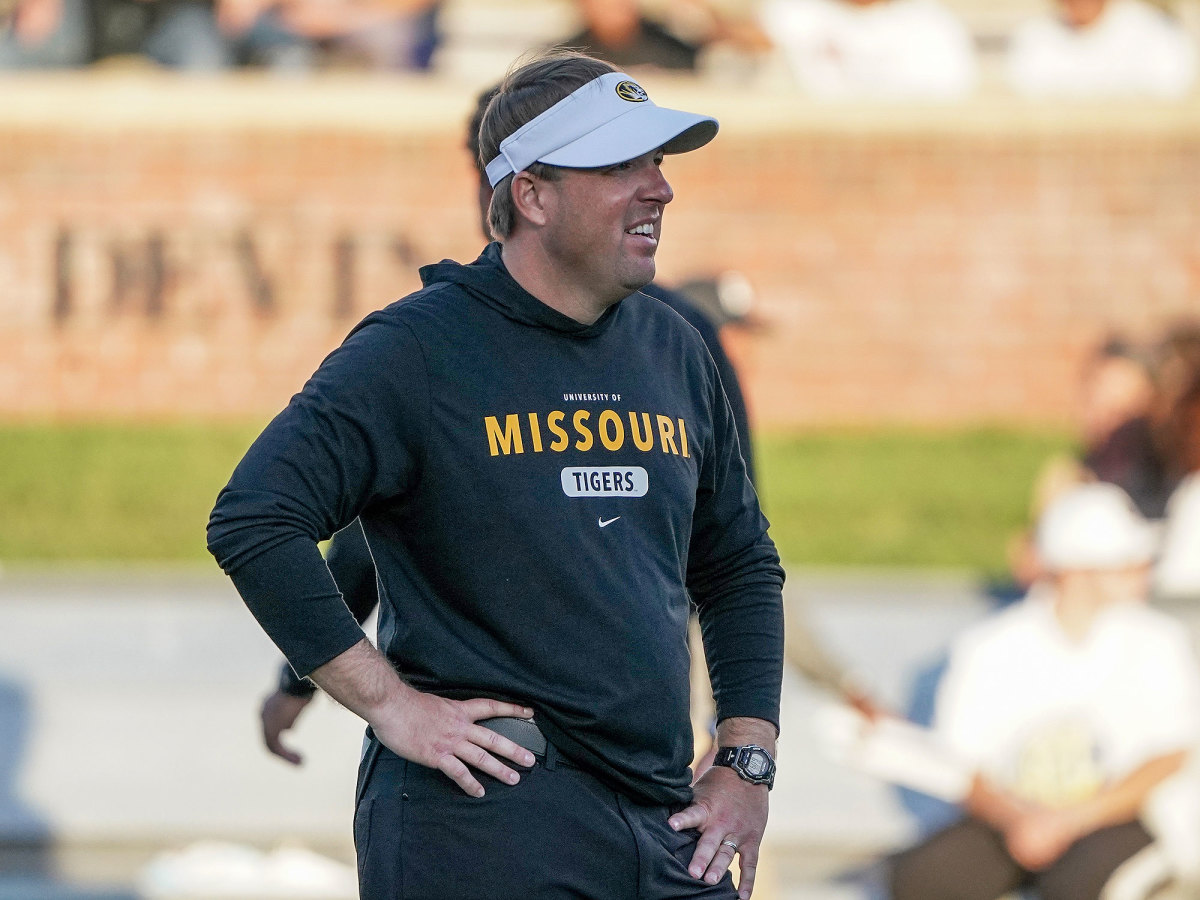Forde-Yard Dash: As Texas A&M’s Season Spirals, It’s Stuck With Jimbo Fisher
Forty names, games, teams and minutiae making news in college football (“The Dangers of Hurdling” TED Talk by Nebraska’s Alante Brown sold separately):
MORE DASH: Playoff Picture | Michigan Question | Comeback Stories
Second Quarter
When It Goes Irretrievably Bad
Texas A&M (11) crossed the Rubicon from a very bad season to a terrible season Saturday, losing to a futile Auburn (12) team that at least showed up to fight for interim coach Cadillac Williams. The Aggies are now 3–7, will not be bowl eligible for the first time since 2008, have lost six in a row for the first time since 1972 and are staggering toward a 1–7 Southeastern Conference record and last place in the SEC West. Last time A&M won fewer than two league games in a season was in ’70, and the conference was the Southwest.
The debacle is exacerbated by off-field issues that have hovered over the Aggies since signing in February what was reputedly the No. 1 recruiting class in history. Mississippi coach Lane Kiffin and Alabama coach Nick Saban raised the issue of A&M buying the class with recruiting inducements cloaked in NIL deals, and coach Jimbo Fisher (13) fired back hard at both of them. Since Fisher went off on Saban six months ago, his program has been under the microscope—and the close-up view isn’t pretty.

There have been injuries and illnesses beyond Fisher’s control. But there also have been ongoing disciplinary issues hinting at an internal chaos that could explain a program with this much talent performing this poorly. There have been multiple suspensions within the touted freshman class, and A&M added an element of the absurd at Auburn when junior standout receiver Muhsin “Moose” Muhammad III apparently was benched for wearing sleeves—something the Aggies receivers reputedly don’t do.
(Dumb team rule? Or dumb reaction to the rule? Yes.)
So it’s come to this in College Station: The school’s competitive pride this fall rests with its juggernaut meat judging team (14), which won another national championship over the weekend. Gig ’em!
As everyone knows, A&M is handcuffed to Fisher for the foreseeable future by the worst contract in a sport full of them. The deal fully guarantees the 10-year, $95 million contract Fisher signed in 2021, which means the Aggies would be on the hook for nearly $86 million if they fired him now. Even at a school with stupid money at its disposal, that would be excessively stupid.
With a more sensible contract, Fisher would be going the way of Dan Mullen and Jim McElwain at Florida, Ed Orgeron at LSU, and Gene Chizik at Auburn. He’d be out. All those coaches had success at their schools, but when it went wrong, it went way wrong. They were summarily fired.
When the wheels fall completely off like they have at A&M in the fifth year of a coach’s tenure, it’s hard to get them back on. Most don’t get a chance to try. But since Fisher won’t get fired, attention turns to the salvage operation.
There will be transfers in bulk and staff changes. There likely will be philosophy changes as well, which could include ripping the play sheet from Fisher’s grasp and putting someone else in charge of calling plays. And along with that should come some introspection from Fisher on his management style and program philosophy. Everything should be on the table.
If Fisher wants a survival guide for how to come back from a breakdown season, he should check the career of Brian Kelly (15). His tenure at Notre Dame hit a 4–8 pothole in 2016, which necessitated a hard reboot. Athletic director Jack Swarbrick involved himself in Kelly’s job searches to hire new staff, and Kelly was tasked with moderating his temperamental personality.
He’s gone 62–11 since then, and just last weekend he clinched the championship of the very division wherein A&M occupies the basement. Kelly’s first LSU team comes to Aggieland on Nov. 26, still in contention for a College Football Playoff berth.
Is that comeback scenario repeatable in the SEC, where the competition is more fierce and the reactions to losses more volatile? We’ll see. But athletic director Ross Bjork has to know that in the current college sports landscape, his tenure is tied to the man he extended in 2021.
“It further shows our commitment not only to coach Fisher but also to Aggie football,” Bjork said at the time. “We’re on the right track to building towards championship-level success.” Record since then: 11–11. No championships in sight.
The administrative risk that comes with an all-in coaching investment
Bjork can ask Shane Lyons (16) about the fallout when a contact extension goes wrong. West Virginia forced Lyons out of the athletic director’s chair Monday, collateral damage for Neal Brown’s unsuccessful tenure to date at the school.
An upset of Oklahoma on Saturday raises Brown’s record at the school to only 21–24, 4–6 this year. Lyons gave him an extension after the 2021 season, despite a 17–18 record to that point. That upped the buyout figure to a reported $20 million, with that number dropping to $16.7 million after Jan. 1.
Lyons reportedly had a “tense meeting” Sunday with school president E. Gordon Gee, according to Metro News of West Virginia. Boosters and fans have been fomenting for Brown’s firing since early in the season, when the Mountaineers opened 0–2.
Texas A&M and West Virginia are hardly alone. Athletic departments have long been in the business of doling out extensions at the first rattling of sabres by aggressive agents. These negotiations often are mismatches along the lines of an FCS opponent visiting a Power 5 school, and the amount of money that subsequently is spent buying out unsuccessful coaches is the biggest fiscal travesty in college sports.

The latest rout: Eli Drinkwitz and agent Jimmy Sexton vs. Missouri (17). Very much out of the blue and unsupported by on-field performance, Mizzou agreed to a raise and two-year extension for Drinkwitz that was announced Nov. 5. His salary was bumped from $4 million to $6 million, despite a record of 15–16 to that point (with one-third of those victories coming against non–Power 5 competition).
Suitably inspired, Missouri has since lost to Kentucky and Tennessee to drop to 4–6 on the season. It needs to beat New Mexico State and Arkansas to attain eligibility for a bowl game that will excite no one.
If you want to dream up a scenario in which there was some market competition for Drinkwitz, it’s this: North Carolina State (18) loses Dave Doeren to Nebraska (or elsewhere), and the Wolfpack come after their onetime offensive coordinator to fill that opening. But it’s hard to imagine why NC State would want to order that particular Drink.
Drinkwitz should get a fourth season at Mizzou in 2023, but anything beyond that should be contingent upon significant progress. And now it’s become much more expensive to dismiss him if need be next year.
Meanwhile, Texas (19) and Oklahoma (20) continued their seasons of disenchantment, and both could be facing big-dollar decisions about their coaches in the coming years as they prepare to head into the lion’s den that is the SEC.
The Longhorns had a big opportunity to prove they’re something other than ordinary Saturday, hosting undefeated TCU, and couldn’t measure up. They never led, were held without an offensive touchdown and for some reason gave star running back Bijan Robinson only 12 touches for 29 yards—effectively ending his Heisman Trophy chances. Putative savior quarterback Quinn Ewers was 17-of-39 for 171 yards and an interception, a third straight performance that undercuts the early-season hype.
Losing to 10–0 TCU is no great shame, but a 6–4 record this year and an 11–11 overall mark for Steve Sarkisian is vastly underwhelming. Recruiting assuredly will earn him a third season—thank you, Arch Manning—but anything beyond that will have to be earned on the field in 2023.
Sark was a questionable hire to begin with by athletic director Chris Del Conte. He’s a guy who didn’t do anything special with two great head coaching opportunities at Washington and USC (he sabotaged himself in Los Angeles). Much like its in-state rival in College Station, Texas has both a lot of money and a lot of noise around the program—when things start slipping, the resulting tumult can accelerate a downward spiral.
At Oklahoma, the debut season of Brent Venables has been a massive bust. The Sooners’ loss to West Virginia drops them to 5–5 and 2–5 in the Big 12, just a game ahead of cellar-dwelling Iowa State. This is Oklahoma’s worst season of the 21st century, with defensive expert Venables presiding over a team that currently is giving up its most points per game (29.1) since 2018 and what would be the fourth-most in school history.
Here, once again, an athletic director over-invested in a coach who hadn’t proved enough at the time of the deal. Venables was given a six-year, $43.5 million contract—a huge number for a first-time head coach, but that’s not all. The contract is fully guaranteed, which is preposterous—and ultimately could be quite costly.
Venables’s tenure certainly will extend past this season and probably beyond 2023 as well. But the start is sobering for a fan base that deluded itself into thinking life would be better very quickly without Lincoln Riley.
MORE DASH: Playoff Picture | Michigan Question | Comeback Stories
